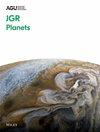Massive Ice Sheet Basal Melting Triggered by Atmospheric Collapse on Mars, Leading to Formation of an Overtopped, Ice-Covered Argyre Basin Paleolake Fed by 1,000-km Rivers
Abstract
Near the Noachian-Hesperian boundary (∼3.6 billion years ago), most of Mars' near-surface water inventory was likely frozen in large southern ice sheets and Mars' CO2 atmosphere had eroded enough that it began to periodically collapse. Here, I report model results showing that thermal blanketing of a southern H2O ice sheet by a CO2 ice cap formed during atmospheric collapse would produce melt equivalent to ∼0.2–2.0 × Mars' present-day global near-surface H2O inventory. I then model downstream flow, demonstrating the likely development of an ice-covered fluviolacustrine system with 1,000s-of-kilometer-long rivers, an overtopped Mediterranean-Sea-sized lake in Argyre Basin, and substantial water delivery into Margaritifer Terra and potentially Chryse Planitia. This study shows that a steady-state hydrologic cycle driven by pole-to-equator melt and equator-to-pole sublimation and atmospheric transport lasting 105–107 year could occur multiple times throughout a ∼108-year window during which atmospheric pressure was low enough to collapse yet CO2 and H2O inventories and geothermal heat output were high enough to produce substantial meltwater. The nature of this proposed hydrologic cycle is consistent with estimates of the timing, duration, and intermittency of Noachian-Hesperian fluvial activity. Thus, meltwater release triggered by atmospheric collapse potentially played an important role in the intense pulse of Noachian-Hesperian fluvial activity: directly so for the Argyre-Margaritifer-Chryse system and perhaps indirectly for other catchments. Finally, this study demonstrates that large amounts of water can mobilize in a cold climate, driven by the same atmospheric collapse process occurring on Mars today, without invoking late-stage warming processes.



 求助内容:
求助内容: 应助结果提醒方式:
应助结果提醒方式:


